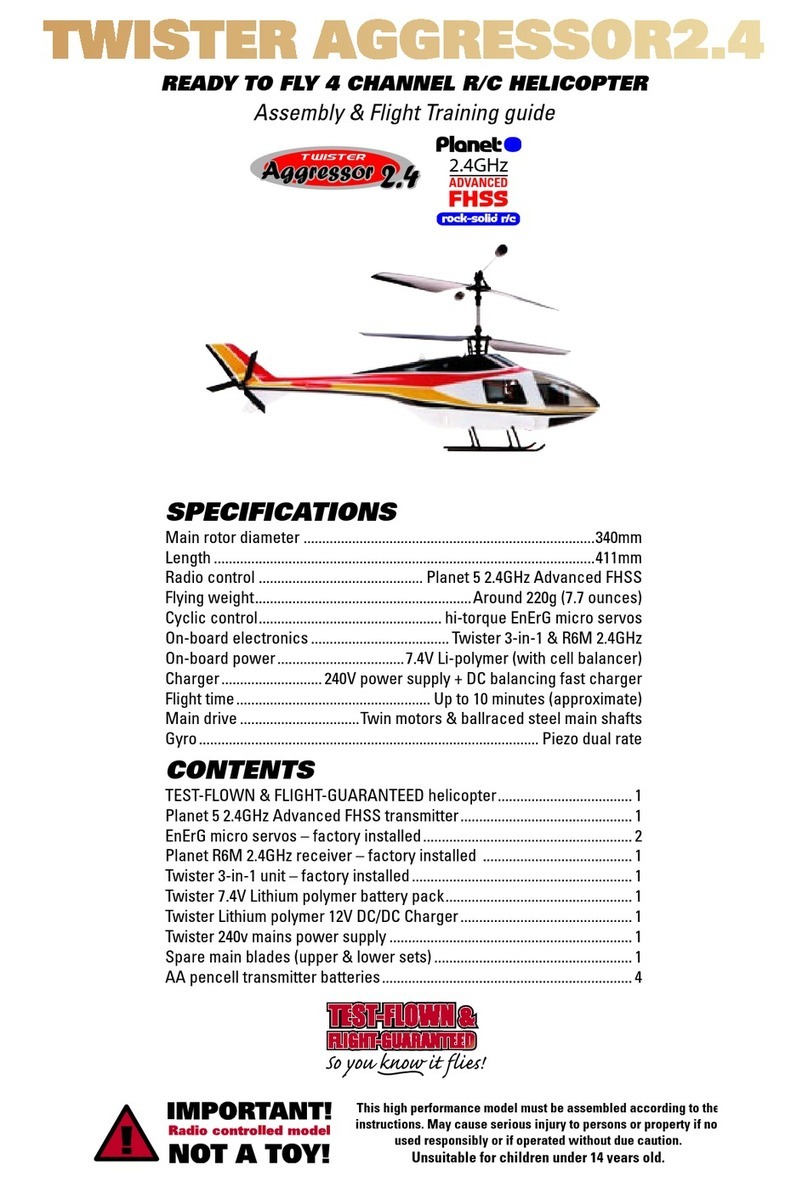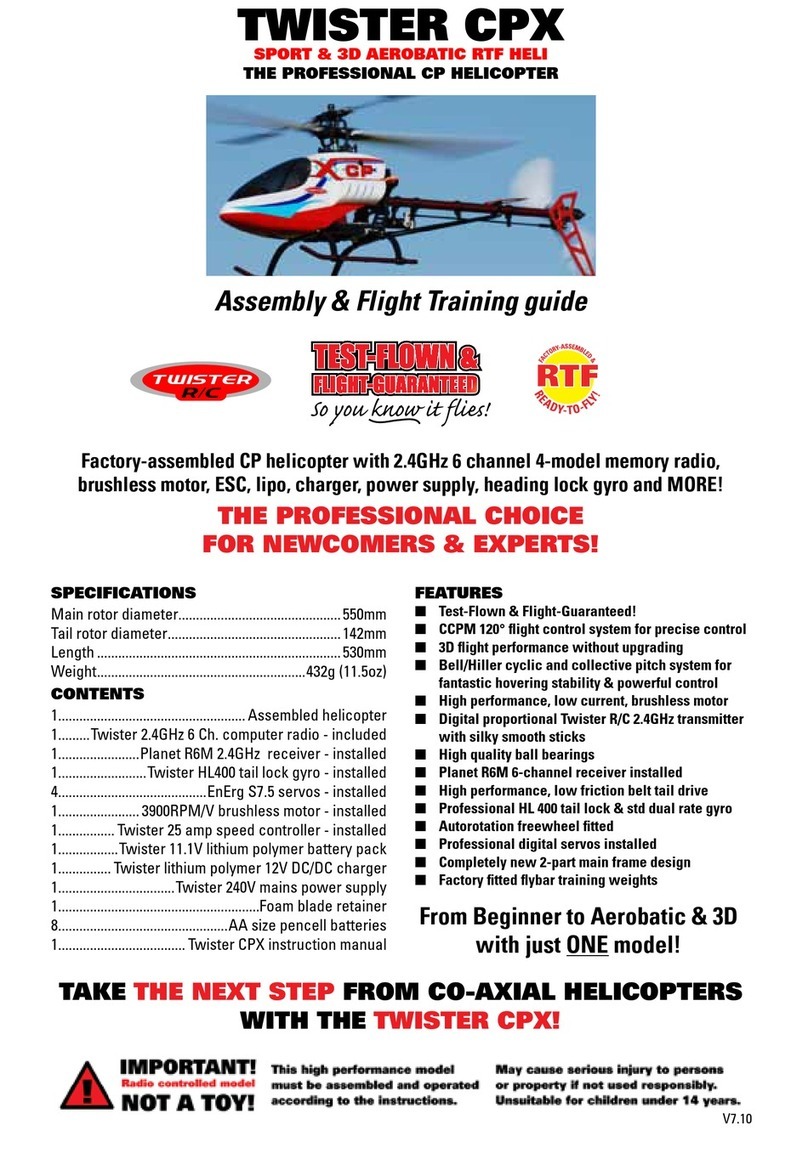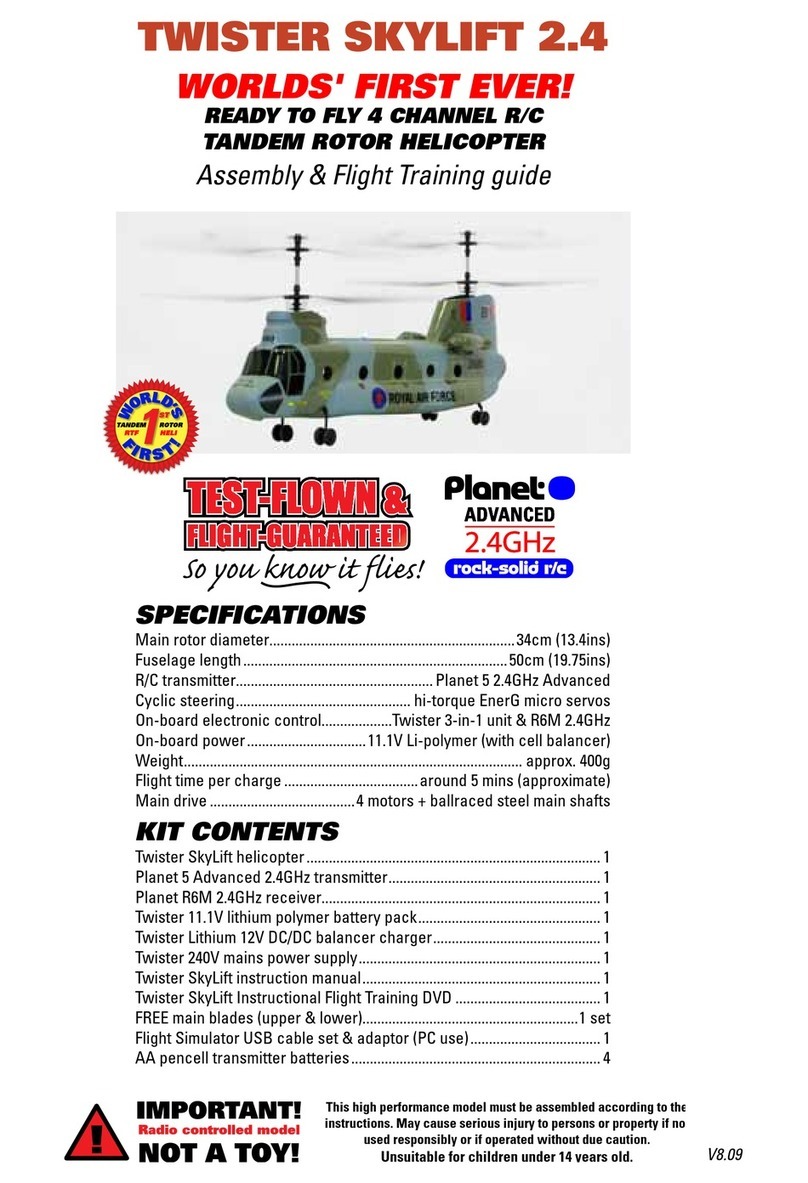Vital Safety info
Please read all instructions carefully before using this
model. If any information in this manual is unclear,
please contact your supplier for help.
Please note especially the potential dangers associated
with the rotating parts in this model:
DANGER—Wear protective eyewear when using model
helicopters!
DANGER—Do not wear loose clothing or ties!
DANGER—Keep well clear of rotating blades!
DANGER—Never fly near children or animals!
about the flyinG aRea
ReQuiRed
The Twister Medevac is designed primarily for indoor
use—or outdoors in flat calm conditions. A hard, flat
surface clear of all obstacles with an area of around 400
square feet is the minimum recommended requirement.
However, you should fly only where it is safe to do so.
about tRaininG,
cRaSheS & SpaRe paRtS
The Twister Medevac has been designed to be strong
and very easy to repair, however, the helicopter is not
invulnerable and most people will tip their helicopter
over or break parts during their flying career. This is
quite normal. All parts are available as spares from
your supplier. Study the exploded view of the helicopter
carefully to understand the relationship between parts
and how to replace them if necessary. Crash damage is
not covered by warranty.
GuaRantee/waRRanty
J. Perkins Distribution Ltd and Model Engines (Aust.) Pty. Ltd.
guarantee this product to be free of manufacturing or assembly
defects for a period of one year from time of purchase. This does
not affect your statutory rights. This warranty is not valid for any
damage or subsequent damage arising as a result of a crash,
misuse, modification or for damage or consequential damage
arising as a result of failure to observe the procedures outlined
in this manual. Operation of this model is carried out entirely
at the risk of the operator. Please note that, whilst every effort
is made to ensure the accuracy of instructions and material
included with this product, mistakes can occur and neither J.
Perkins Distribution Ltd/Model Engines (Aust.) Pty. Ltd. nor it’s
distributors will be held liable for any loss or damage arising
from the use of this model or for any loss or damage arising from
omissions or inaccuraccies in the associated instructions or
materials included with this product.
We reserve the right to modify the design of this product,
contents and manuals without prior notification.
© 2007 J Perkins Distribution Ltd, Lenham, Kent, UK ME17 2DL.
www.jperkinsdistribution.co.uk
Model Engines (Aust.) Pty. Ltd., Noble Park, Victoria 3174,
Australia. www.modelengines.com.au. All rights reserved. E&OE.
table of contentS
Guarantee/warranty ........................................ 2
Introduction ...................................................... 3
New to R/C helicopters? ................................ 3
General safety concerning helicopters ...... 4
Welcome ........................................................... 4
A. Kit contents .......................................... 4
B. Transmitter part names ...................... 5
C. Reversing switches ............................. 5
D. Transmitter mode conversion ........... 5
Flight preparation ............................................ 6
A. Fitting the flybar ................................... 6
B. Lithium polymer flight battery ............ 7
C. Charging the flight battery ................. 7
D. Fitting the flight battery ...................... 8
E. Linkage checks .................................... 8
Transmitter layout throttle left (mode 2) ...... 9
A. Stick and trim control summary ........ 9
Transmitter layout throttle right (mode 1) ... 10
A. Stick and trim control summary ........ 10
Power checks and connecting up ............... 11
A. Connecting the Li-po battery ............. 11
B. Swashplate level check(Mode 2) ..... 12
C. Swashplate roll check(Mode 2 ) ....... 12
D. Swashplate elevator check(Mode 2) 13
E. Throttle check(Mode 2 transmitter) .. 13
F. Yaw check .............................................. 13
G. Range check ........................................ 14
Flight controls mode 2 .................................... 14
A. flight controls layout ........................... 14
B. Right stick unit functions .................... 15
C. Left stick unit functions ...................... 15
Flight controls mode 1 .................................... 16
A. flight controls layout ........................... 16
B. Right stick unit functions .................... 17
C. Left stick unit functions ...................... 18
Fine tuning of yaw control ............................. 19
3 in 1 unit adjustors .................................. 19
Damage prevention features ......................... 19
LBW (Low Battery Warning) beacon .... 19
MOPS ......................................................... 19
How does a helicopter fly? ............................ 20
Flight training guide ........................................ 21
The flying area .......................................... 21
Positioning your Twister Medevac ....... 21
Increase throttle gently ........................... 21
Walking the helicopter ............................ 21
Taking the first 'hop' ................................ 22
Hovering and manoeuvres ..................... 22
Beyond the hover ..................................... 22
Troubleshooting ............................................... 23
Lithium polymer battery safety...................... 23
Parts listing....................................................... 24
Exploded view.................................................. 26
USB PC flight simulator cable ....................... 27
Option Parts ...................................................... 27
Binding the TX to the RX................................. 30





































